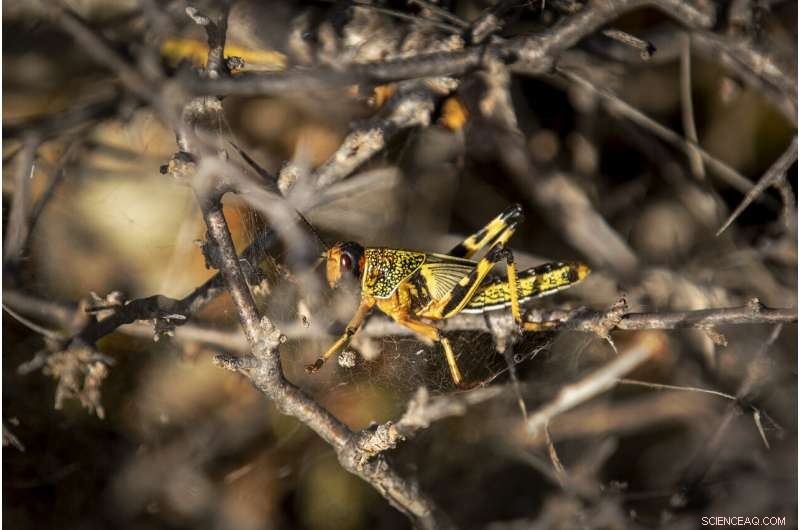
En esta foto tomada el martes, 4 de febrero 2020, una langosta del desierto joven a la que aún no le han crecido las alas está atrapada en una telaraña en un arbusto espinoso en el desierto cerca de Garowe, en la región semiautónoma de Puntlandia en Somalia. Las langostas del desierto en esta zona árida del norte de Somalia parecen menos ominosas que los enjambres de miles de millones de miembros que infestan el este de África. pero los saltadores de langostas jóvenes son la próxima ola del brote que amenaza a más de 10 millones de personas en toda la región con una grave crisis de hambre. (Foto AP / Ben Curtis)
De un vistazo las langostas del desierto en esta zona árida del norte de Somalia parecen menos ominosas que los enjambres de mil millones de miembros que infestan África oriental en el peor brote que algunos lugares han visto en 70 años.
Pero llegará su momento.
Pequeño y sin alas Los saltadores de langostas jóvenes son la próxima ola del brote que amenaza a más de 10 millones de personas en toda la región con una grave crisis de hambre.
Y están creciendo en uno de los lugares más inaccesibles del planeta. Grandes zonas de Somalia al sur de esta región semiautónoma de Puntlandia están amenazadas, o retenido por, el grupo extremista al-Shabab vinculado a Al Qaeda. Eso hace que sea difícil o imposible realizar la fumigación aérea de las langostas que, según los expertos, es el único control efectivo.
Somalia ha declarado que el brote es una emergencia nacional. En toda la región tiene el potencial "de ser la plaga de langostas más devastadora en cualquiera de nuestros recuerdos vivos si no reducimos el problema más rápido de lo que lo estamos haciendo en este momento, ", Dijo el jefe humanitario de la ONU, Mark Lowcock.
Mientras un policía somalí armado estaba al lado, Los expertos caminaron el jueves por la tierra seca plagada de langostas jóvenes y explicaron la amenaza que se avecina si el mundo no actúa ahora mismo.
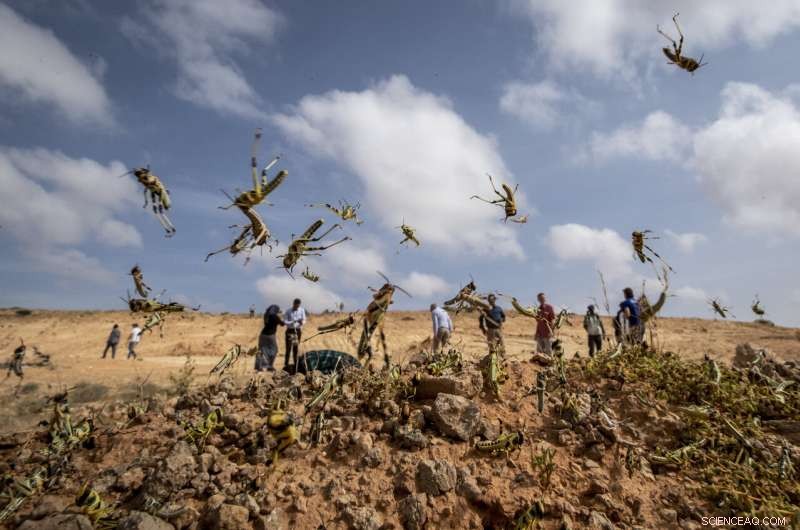
En esta foto tomada el miércoles, 5 de febrero 2020, las langostas jóvenes del desierto a las que aún no les han crecido las alas saltan en el aire cuando se les acercan, como los observa una delegación visitante de la Organización de las Naciones Unidas para la Agricultura y la Alimentación (FAO), en el desierto cerca de Garowe, en la región semiautónoma de Puntlandia en Somalia. Las langostas del desierto en esta zona árida del norte de Somalia parecen menos ominosas que los enjambres de miles de millones de miembros que infestan el este de África. pero los saltadores de langostas jóvenes son la próxima ola del brote que amenaza a más de 10 millones de personas en toda la región con una grave crisis de hambre. (Foto AP / Ben Curtis)
"El mundo necesita saber que aquí es donde comienza todo, "dijo Alberto Trillo Barca, un portavoz de la Organización de las Naciones Unidas para la Agricultura y la Alimentación. "En las próximas tres o cuatro semanas, estas ninfas, como los llamamos, desarrollará alas ".
Luego se espera que partan hacia las vecinas Kenia y Etiopía, donde un puñado de aviones que rocían pesticidas solo puede hacer mucho si continúan llegando esos enjambres.
Los expertos en clima han señalado lluvias inusualmente fuertes, ayudado por un poderoso ciclón frente a Somalia en diciembre, como factor principal del brote. Las langostas fueron transportadas por los vientos de la tormenta desde la Península Arábiga y partes más allá, y ahora se alimentan de la vegetación fresca de Somalia.
Con más lluvias previstas en la región en las próximas semanas, el número de langostas, si no se controla, podría aumentar hasta 500 veces en junio, cuando se espera un clima más seco.
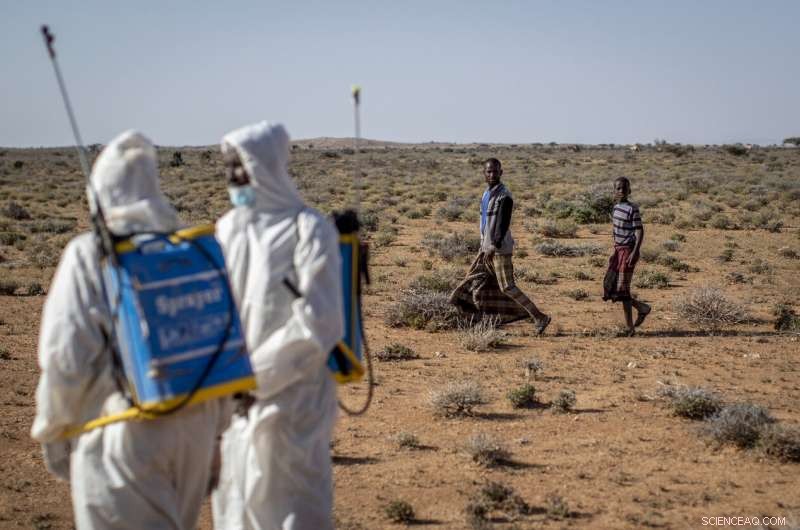
En esta foto tomada el martes, 4 de febrero 2020, Los fumigadores somalíes para el control de plagas demuestran su trabajo en los arbustos espinosos del desierto, que es el caldo de cultivo de las langostas del desierto, para una delegación visitante de funcionarios del ministerio somalí y expertos de la Organización de las Naciones Unidas para la Agricultura y la Alimentación (FAO). en el desierto cerca de Garowe, en la región semiautónoma de Puntlandia en Somalia. Las langostas del desierto en esta zona árida del norte de Somalia parecen menos ominosas que los enjambres de miles de millones de miembros que infestan el este de África. pero los saltadores de langostas jóvenes son la próxima ola del brote que amenaza a más de 10 millones de personas en toda la región con una grave crisis de hambre. (Foto AP / Ben Curtis)
Pero ese clima más seco no es necesariamente la solución, dijo Dominique Burgeon, el director de emergencias y resiliencia de la FAO.
La densidad de las langostas es ahora tan alta que incluso la humedad normal puede dar lugar a otra generación, él dijo.
"No podemos creer en la madre naturaleza para solucionarlo, " él explicó.
Sin suficiente fumigación para detener los enjambres, el ya preocupante brote podría convertirse en una plaga, "y cuando tienes una plaga, se necesitan años para controlar " él dijo.
Contra esa perspectiva arrolladora, Unos pocos trabajadores enmascarados con trajes protectores blancos y envases de plaguicidas atados a la espalda estaban en el desierto somalí atravesado por camellos. rociando las miles de langostas que se aferran a los arbustos espinosos.
El clima cambiante del mundo conlleva el riesgo de que lleguen más ciclones desde el calentamiento del Océano Índico frente a África Oriental, dicen los expertos en clima. Con ese, aumenta la probabilidad de que se produzcan nuevos brotes de langostas.
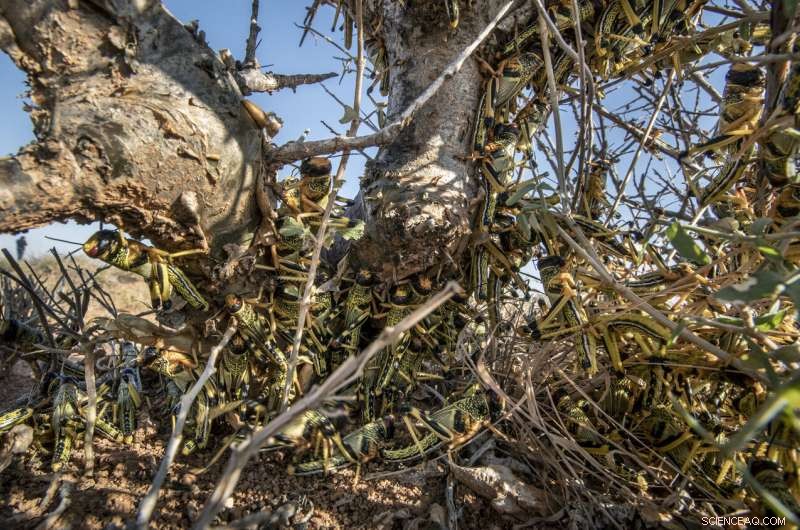
En esta foto tomada el martes, 4 de febrero 2020, jóvenes langostas del desierto a las que aún no les han crecido las alas se amontonan en un arbusto espinoso en el desierto cerca de Garowe, en la región semiautónoma de Puntlandia en Somalia. Las langostas del desierto en esta zona árida del norte de Somalia parecen menos ominosas que los enjambres de miles de millones de miembros que infestan el este de África. pero los saltadores de langostas jóvenes son la próxima ola del brote que amenaza a más de 10 millones de personas en toda la región con una grave crisis de hambre. (Foto AP / Ben Curtis)
El "tipo de nueva normalidad, "Dijo Burgeon.
Y eso significa Kenia, Etiopía y otros países de África Oriental que rara vez ven este tipo de brotes y se encuentran en gran medida poco preparados para este podrían unirse a los "países de primera línea" en partes de África Occidental y Oriente Medio. los expertos dicen. Esos países cuentan con sistemas bien capacitados de vigilancia y prevención para los brotes de langosta más frecuentes.
La FAO ha pedido a los donantes internacionales que aporten inmediatamente 76 millones de dólares para ayudar a controlar este brote. Hasta ahora, $ 19 millones están disponibles, Dijo Burgeon.
"El mayor desafío es la escala de la cría, como puedes ver a nuestro alrededor, "Dijo el Barça. Estas langostas, él dijo, will be migrating to southern Somalia and parts of Kenya and Ethiopia just as crops are germinating there.
"If at that time there are huge quantities of locusts around, it will have a devastating impact on the crops, " Burgeon said.
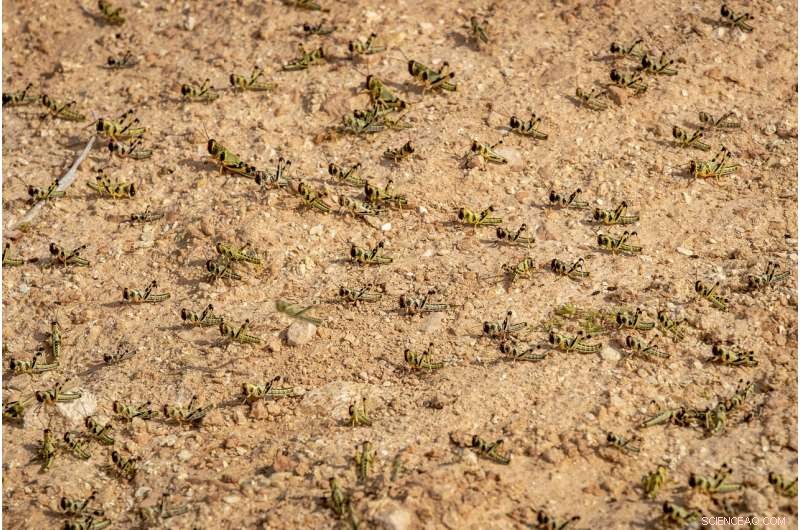
In this photo taken Wednesday, Feb. 5, 2020, young desert locusts that have not yet grown wings cover the ground in the desert near Garowe, in the semi-autonomous Puntland region of Somalia. The desert locusts in this arid patch of northern Somalia look less ominous than the billion-member swarms infesting East Africa, but the hopping young locusts are the next wave in the outbreak that threatens more than 10 million people across the region with a severe hunger crisis. (AP Photo/Ben Curtis)
Other East African countries including Uganda, South Sudan, Eritrea and Djibouti are also at risk, Burgeon said. Millions of people in some of these places are already facing hunger in the wake of civil war or more common challenges such as poverty.
Here in rural Somalia, where about 50% of the people depend on animals for their livelihoods, the locusts are eating the pasturage. The animals weaken, their milk decreases and small children, who depend on the milk to survive, suffer skyrocketing malnutrition, dijeron los expertos.
Those fighting the locust outbreak may try to negotiate with Somalia's extremist fighters to allow spraying in rural areas where they are active, Burgeon said. Already emergency workers are going in where they can.
In a few weeks the young locusts will shed their skin, said Keith Cressman, a senior locust forecasting officer with the FAO.
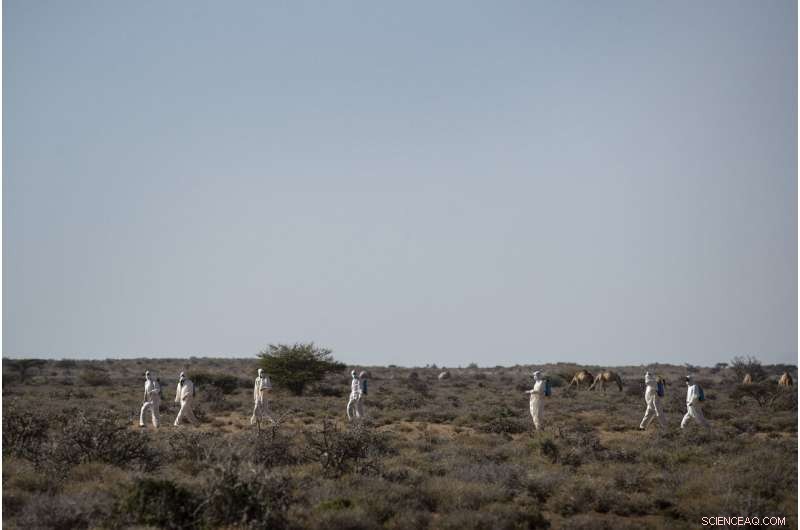
In this photo taken Tuesday, Feb. 4, 2020, Somali pest-control sprayers demonstrate their work on the thorny bushes in the desert that is the breeding ground of desert locusts for a visiting delegation of Somali ministry officials and experts from the Food and Agriculture Organization (FAO), in the desert near Garowe, in the semi-autonomous Puntland region of Somalia. The desert locusts in this arid patch of northern Somalia look less ominous than the billion-member swarms infesting East Africa, but the hopping young locusts are the next wave in the outbreak that threatens more than 10 million people across the region with a severe hunger crisis. (AP Photo/Ben Curtis)
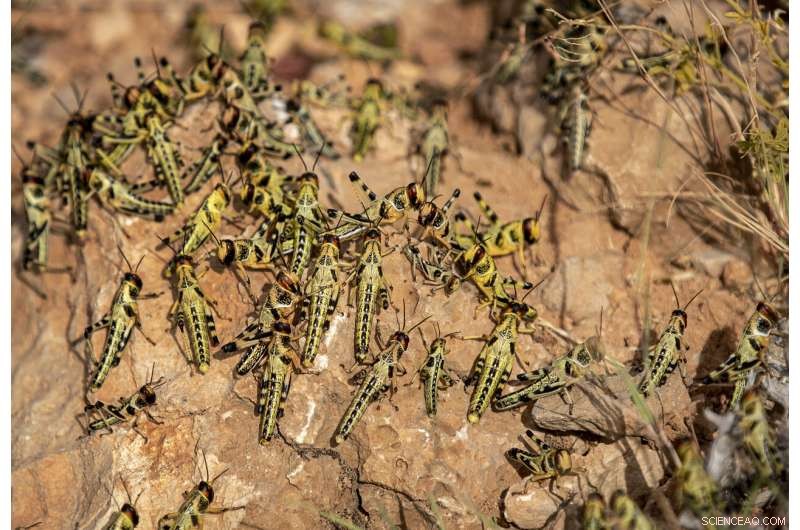
In this photo taken Wednesday, Feb. 5, 2020, young desert locusts that have not yet grown wings crowd together on a rock in the desert near Garowe, in the semi-autonomous Puntland region of Somalia. The desert locusts in this arid patch of northern Somalia look less ominous than the billion-member swarms infesting East Africa, but the hopping young locusts are the next wave in the outbreak that threatens more than 10 million people across the region with a severe hunger crisis. (AP Photo/Ben Curtis)
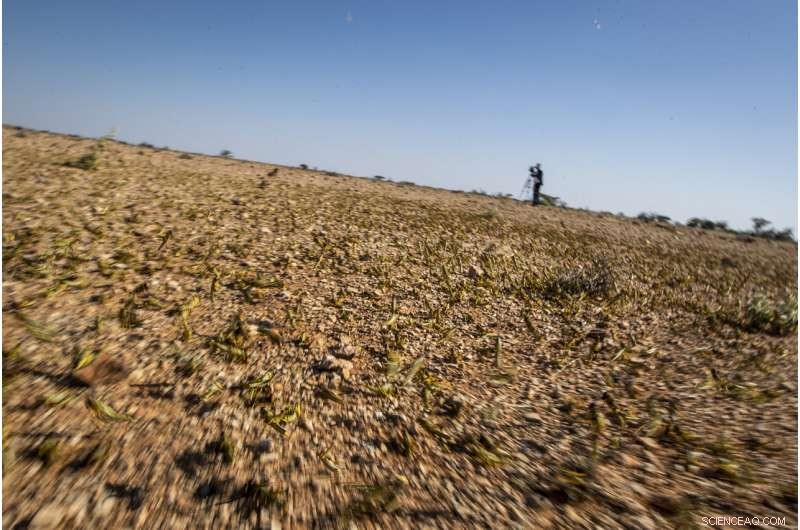
In this photo taken Tuesday, Feb. 4, 2020, young desert locusts that have not yet grown wings jump in the air as they are approached in the desert near Garowe, in the semi-autonomous Puntland region of Somalia. The desert locusts in this arid patch of northern Somalia look less ominous than the billion-member swarms infesting East Africa, but the hopping young locusts are the next wave in the outbreak that threatens more than 10 million people across the region with a severe hunger crisis. (AP Photo/Ben Curtis)
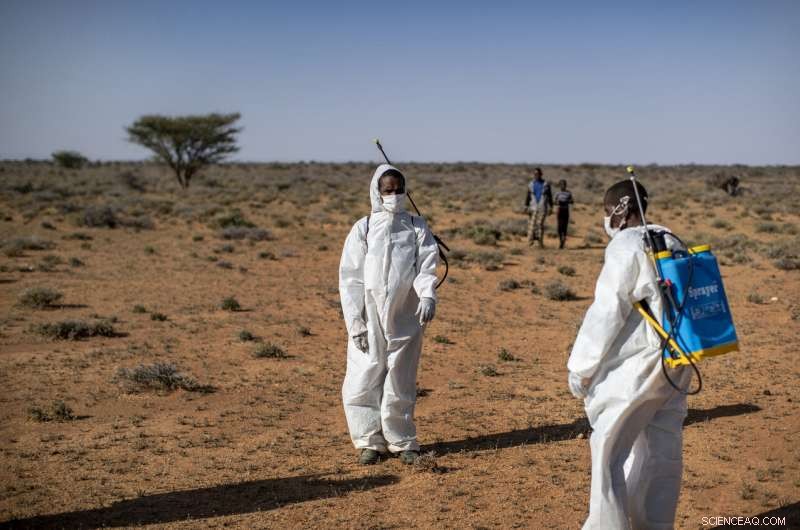
In this photo taken Tuesday, Feb. 4, 2020, Somali pest-control sprayers demonstrate their work on the thorny bushes in the desert that is the breeding ground of desert locusts for a visiting delegation of Somali ministry officials and experts from the Food and Agriculture Organization (FAO), in the desert near Garowe, in the semi-autonomous Puntland region of Somalia. The desert locusts in this arid patch of northern Somalia look less ominous than the billion-member swarms infesting East Africa, but the hopping young locusts are the next wave in the outbreak that threatens more than 10 million people across the region with a severe hunger crisis. (AP Photo/Ben Curtis)
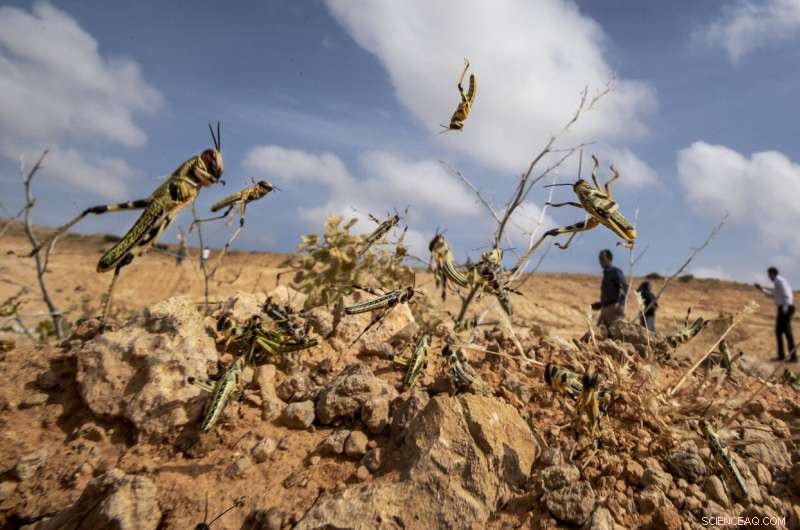
In this photo taken Wednesday, Feb. 5, 2020, young desert locusts that have not yet grown wings jump in the air as they are approached, as a visiting delegation from the Food and Agriculture Organization (FAO) observes them, in the desert near Garowe, in the semi-autonomous Puntland region of Somalia. The desert locusts in this arid patch of northern Somalia look less ominous than the billion-member swarms infesting East Africa, but the hopping young locusts are the next wave in the outbreak that threatens more than 10 million people across the region with a severe hunger crisis. (AP Photo/Ben Curtis)

In this photo taken Tuesday, Feb. 4, 2020, pest-control sprayers demonstrate their work on the thorny bushes in the desert that is the breeding ground of desert locusts for a visiting delegation of Somali ministry officials and experts from the Food and Agriculture Organization (FAO), in the desert near Garowe, in the semi-autonomous Puntland region of Somalia. The desert locusts in this arid patch of northern Somalia look less ominous than the billion-member swarms infesting East Africa, but the hopping young locusts are the next wave in the outbreak that threatens more than 10 million people across the region with a severe hunger crisis. (AP Photo/Ben Curtis)
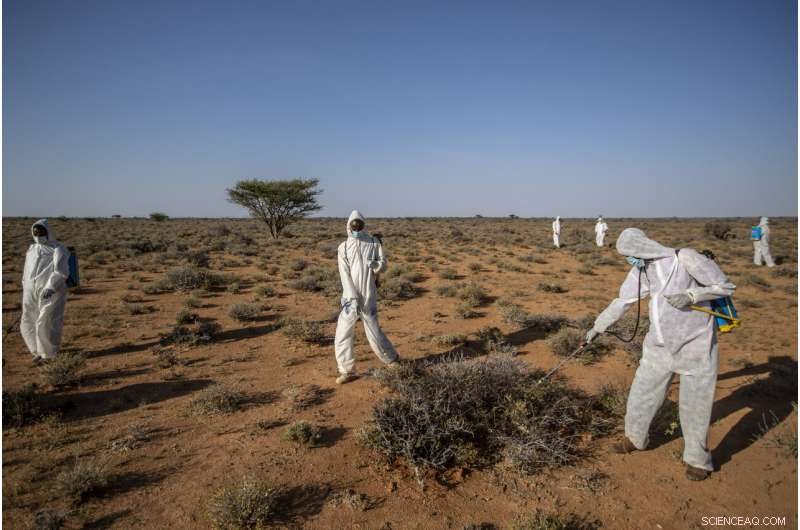
In this photo taken Tuesday, Feb. 4, 2020, pest-control sprayers demonstrate their work on the thorny bushes in the desert that is the breeding ground of desert locusts for a visiting delegation of Somali ministry officials and experts from the Food and Agriculture Organization (FAO), in the desert near Garowe, in the semi-autonomous Puntland region of Somalia. The desert locusts in this arid patch of northern Somalia look less ominous than the billion-member swarms infesting East Africa, but the hopping young locusts are the next wave in the outbreak that threatens more than 10 million people across the region with a severe hunger crisis. (AP Photo/Ben Curtis)
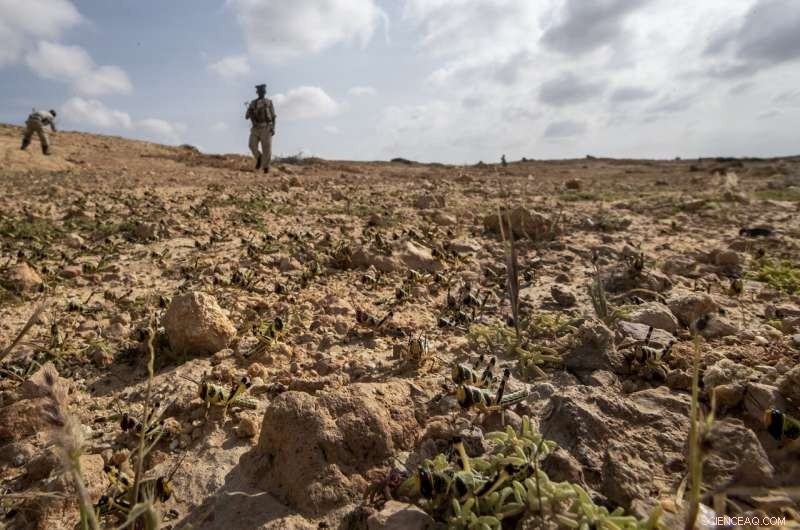
In this photo taken Wednesday, Feb. 5, 2020, a policeman looks at young desert locusts that have not yet grown wings covering the ground in the desert near Garowe, in the semi-autonomous Puntland region of Somalia. The desert locusts in this arid patch of northern Somalia look less ominous than the billion-member swarms infesting East Africa, but the hopping young locusts are the next wave in the outbreak that threatens more than 10 million people across the region with a severe hunger crisis. (AP Photo/Ben Curtis)
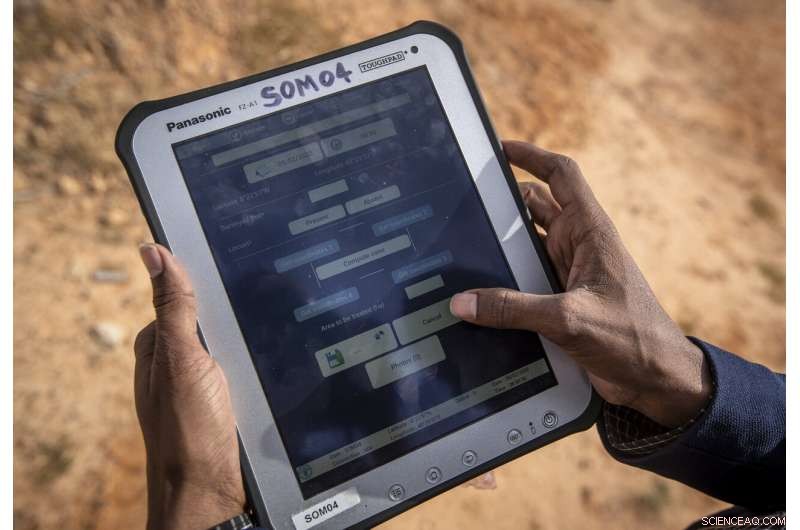
In this photo taken Wednesday, Feb. 5, 2020, an official from the Food and Agriculture Organization (FAO) demonstrates the "eLocust3" software used to record and track the location and movements of locusts using GPS and transmit the data via satellite, in the desert near Garowe, in the semi-autonomous Puntland region of Somalia. The desert locusts in this arid patch of northern Somalia look less ominous than the billion-member swarms infesting East Africa, but the hopping young locusts are the next wave in the outbreak that threatens more than 10 million people across the region with a severe hunger crisis. (AP Photo/Ben Curtis)

In this photo taken Wednesday, Feb. 5, 2020, Dominique Burgeon, centrar, Director of the Emergency and Resilience Division of the Food and Agriculture Organization (FAO) and Keith Cressman, Derecha, Senior Locust Forecasting Officer for FAO, walk in the desert between Garowe and Qardho, in the semi-autonomous Puntland region of Somalia. The desert locusts in this arid patch of northern Somalia look less ominous than the billion-member swarms infesting East Africa, but the hopping young locusts are the next wave in the outbreak that threatens more than 10 million people across the region with a severe hunger crisis. (AP Photo/Ben Curtis)
"It takes a few days to warm up their wings, " he said. Some test flights follow and they're on the move.
The locusts at that stage are bright pink and in their most voracious state, like "very hungry teenagers, " Cressman said. By now, many people in Kenya and Ethiopia know them well.
After a month or so, the locusts will be mature adults, ready to reproduce.
Soon after copulating and laying eggs the locusts will die, "but their progeny will be hatching, " Cressman said. "And we have another generation of locusts to contend with, with about another 20-fold increase."
© 2020 The Associated Press. Reservados todos los derechos.